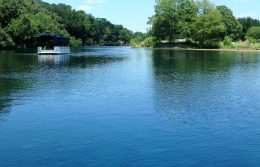Texas’ Longest Wilderness Footpath: The Lone Star Hiking Trail
The most famous trails in the United States traverse multiple states and cross some of the most magnificent terrain on earth. On the East Coast, the Appalachian Trail runs up the spine of the Appalachian Mountains. Out west, the Pacific Crest Trail cuts along the Sierra Nevada on its route toward the Pacific coast. The Continental Divide Trail begins in New Mexico and rises 14,000 feet, taking travelers on a long and rugged journey all the way to Montana.
Because Texas sits in the center of the country, it isn’t touched by any of these famous long trails. Although there’s no shortage of magnificent landscape and scenery, the state lacked what is known as a hike-through trail — one that is long enough that backpackers and hikers can spend days, even weeks or months, losing themselves in the wilderness.
In 1966, The Lone Star Chapter of the Sierra Club set out to change that.
Room for a Trail Deep in the Heart of Texas
The closest the state had were the trails in Big Bend National Park, some of which wander through the desert at lengths that can take three or four days to cross. But the Sierra Club was thinking bigger, and that’s how the idea of the Lone Star Hiking Trail was born.
There are certainly more rugged and spectacular terrains in Texas than the dense, swampy forests of the southeastern corner of the state. But when the Lone Star Chapter of the Sierra Club began looking for a location for its hike-through trail, it found in Sam Houston National Forest a huge expanse of natural beauty that was remote and inaccessible to most people.
In 1967, the U.S. Forest Service assessed construction of a trail through the forest. The Sierra Club, Boy Scouts of America, and other volunteers and volunteer organizations began mapping out the trail. The first 30 miles opened in 1968, and by 1978, the trail had grown to a whopping 96 miles, with 32 miles of additional loops and crossover trails.
Where the West Meets the East
The western end of the trail begins along Forest Service Road 219A, just a few miles east of the small town of Richards. From there it bends to the south, before winding up to run along the northern tip of Lake Conroe, offering splendid views of the lake, particularly in autumn when the leaves change colors, and continuing on a long horseshoe bend through Sam Houston National Forest and ending outside of Cleveland.
There are parking lots and access points all the way along the trail, and even if you can’t hike the entire length of the trail in one fell swoop, it is easy to explore sections of it one chunk at a time.
A Long Walk in the Woods
Unlike the more well-known hike-through trails, the Lone Star Hiking Trail is a relatively easy hike, with few great changes in elevation. That doesn’t mean that it is lacking in beauty. Winding through the deep, dark Texas woods, it carves a path through dense vegetation and crosses over soggy bogs, creaks, streams, and lakes.
One of the highlights of the eastern portion of the trail is Big Creek Scenic Area. The area is lush and verdant, particularly in spring, when wildflowers bloom across the section of the forest cut through with streams and creeks.
Bird-watchers will also be greeted with a chance to see most of the birds that are typical of the eastern Texas Piney Woods region, including the endangered red-cockaded woodpecker.
Exploring the Trail
No Texan needs to be reminded that summers are hot, and in the southeastern corner of the state, the high humidity can make traveling the Lone Star Hiking Trail a challenge in the warmer months. Most long-haul hikers take advantage of Texas’ temperate winters and hike the trail between October and April. Because of hunting season, there are some restrictions on camping during September and January, and hikers would be wise to wear bright clothing.
Finding Water
Most of the trail is remote, which means an adventure requires some carefully planning. Water is available, and the Lone Star Hiking Trail Club tries to keep up-to-date information about water sources on its website. But water in Texas dries up quickly, and hikers should plan to carry emergency supplies, particularly in the summer months, in the event that an anticipated water source can’t be found. In addition to providing trail maintenance, the Lone Star Hiking Trail Club organizes group hikes for all experience levels and offers maps to trailheads, parking, and sections of the trail on its website.
Sleeping Under the Stars
One of Sam Houston National Forest’s most defining features is its thick forest canopy, which makes a journey along the Lone Star Hiking Trail perfect for hammock camping. A hammock can also keep campers off the ground, which can be soggy and boggy in parts. Primitive camping is permitted all along the trail, though some of the parks the trail passes through, like Lake Conroe, offer opportunities for more traditional camping facilities as well as luxuries like restrooms.
But regardless of whether you plan to travel Texas’ only hike-through trail in its entirety or just sample a section of its beauty, the Lone Star Hiking Trail is a must-see for any Lone Star outdoor explorer.
Find more uniquely Texan adventures here.
© 2018 Texas Farm Bureau Insurance



